Last weekend I spent a couple days boating around Akanda National Park, looking for manatees, sea turtles and talking to fishermen to see if they hunt or see manatees or turtles. On Friday morning 3 of us boated a zodiac from Libreville around a peninsula (open ocean but relatively calm) to the very shallow bay at Akanda. The water is murky and it was hard to see the depth- we actually got stuck in the mud and had a very funny experience trying to walk the boat to deeper water.
On Friday afternoon we visited a Nigerian fishing village on a small river. They mostly fish in the ocean rather than the bay, and they catch shrimp and spiny lobsters as well as fish. The chief told us in his 9 years there he had never seen a manatee, but that they catch about 2 turtles a week (although they don't differentiate between freshwater and sea turtles, so it's hard to know exactly how many are sea turtles, but they shouldn't be taking any, so obviously there's a negative impact). We also surveyed a smaller bay and a couple rivers. It is mangrove habitat, so impossible to see manatee feeding sign, and we saw no manatees or turtles.
The following day I went out again with a boat driver and two friends, Josey and Ruth. Unfortunately we got about 5km from the marina and ran out of gas. This was due to several factors- a gas gauge that didn't work, my misunderstanding of the amount of gas we had used the previous day, and a boat driver who decided not to tell us we were low on gas before we left the dock. So we spent a couple hours intensively studying a particular section of the river while paddling and not really getting very far! Eventually we persuaded some fishermen to tow us back to the marina in exchange for some money and a couple beers. They ended up giving us some fresh lobster so it was a pretty good trade! We also talked to them about manatees and they said they had never seen any there. It's hard to know if they are telling the truth, but with the intensive fishing that takes place there, my guess is that if there are any manatees at all, they are very few.
Sunday we had a torrential downpour and didn't end up going out on the water, so unfortunately we were never able to survey the eastern side of the bay. Monday morning my friends Romain, Bruno, Ant and I moved the boat back to Libreville, of course in perfect sunny weather! I wish I could've spent longer up there, but I had to leave Gabon that night. The boat belongs to Romain, so I thank him very much for letting us use it!
 Nigerian fishing village in the large shallow bay. This is one of at least 3 villages in the park.
Nigerian fishing village in the large shallow bay. This is one of at least 3 villages in the park.  Josey with a paddle, right before we got stuck in the mud. Little did we know at the time this picture was taken how important the paddles would become!
Josey with a paddle, right before we got stuck in the mud. Little did we know at the time this picture was taken how important the paddles would become!I want to put up as few more pics from Akanda soon, but am having trouble loading at the moment.

 Cool Guitarfish I saw swimming along the shore.
Cool Guitarfish I saw swimming along the shore.



 Sunset on the savannah.
Sunset on the savannah. Pongara is known for leatherback sea turtle nesting, but the season has just started. I saw a couple nests (huge! They literally look like a bulldozer has come through), but no turtles. Only about half the nest is visible in this photo. There is good protection in place and an NGO (Adventures sans Frontiers) who have a research station on the beach and do nest monitoring, but there are still quite a few off road quad cycles going up and down the beach.
Pongara is known for leatherback sea turtle nesting, but the season has just started. I saw a couple nests (huge! They literally look like a bulldozer has come through), but no turtles. Only about half the nest is visible in this photo. There is good protection in place and an NGO (Adventures sans Frontiers) who have a research station on the beach and do nest monitoring, but there are still quite a few off road quad cycles going up and down the beach.  Our host, hard at work editting his elephant book:
Our host, hard at work editting his elephant book:
 Mum Sandra and Kath Jeffery. Kath has been in Gabon for most of the last 10 years and is the Assistant Director of Lope National Park. Sandra was visiting from England. The three of us had alot of laughs together!
Mum Sandra and Kath Jeffery. Kath has been in Gabon for most of the last 10 years and is the Assistant Director of Lope National Park. Sandra was visiting from England. The three of us had alot of laughs together! 
 This is a picture of the peninsula at Port Gentil, which is the westernmost point in Gabon, and the site of an old whaling station. Tim would like to try to collect samples of old whale bone there, to look at DNA and compare it with samples they get from living whales now.
This is a picture of the peninsula at Port Gentil, which is the westernmost point in Gabon, and the site of an old whaling station. Tim would like to try to collect samples of old whale bone there, to look at DNA and compare it with samples they get from living whales now. The sunset Tuesday night at the local favorite beach bar in Libreville, a great place to get a Regab and watch the sun go down.
The sunset Tuesday night at the local favorite beach bar in Libreville, a great place to get a Regab and watch the sun go down. Brice and Pierre, getting in touch with their feminine side.
Brice and Pierre, getting in touch with their feminine side. Tim demonstrates Tse Tse fly defense gear.
Tim demonstrates Tse Tse fly defense gear. My best bird photo so far... a Blue-breasted Bee-eater
My best bird photo so far... a Blue-breasted Bee-eater


 The main living / dining platform overlooking the river
The main living / dining platform overlooking the river The view from the platform at sunset
The view from the platform at sunset A hippo in the river
A hippo in the river


 I have so many incredible pictures, but the internet is slow, so I'll have to post more later.
I have so many incredible pictures, but the internet is slow, so I'll have to post more later.
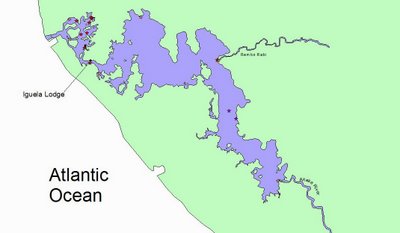

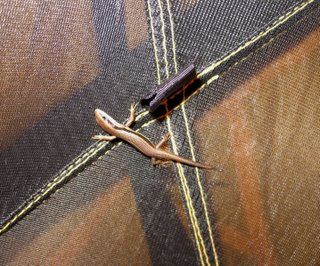 Little skink on patrol for bugs in my tent. He was about 2 inches long, but will grow to about 8 inches.
Little skink on patrol for bugs in my tent. He was about 2 inches long, but will grow to about 8 inches.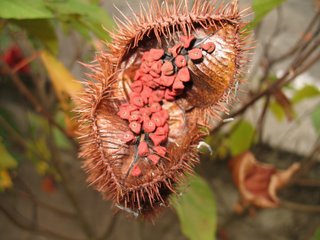 Really cool seed pod! Looks like something out of Little Shop of Horrors.
Really cool seed pod! Looks like something out of Little Shop of Horrors. A peaceful spot on the lagoon
A peaceful spot on the lagoon
 Tree at Evaro, note water line
Tree at Evaro, note water line Forest on the Rembo Rabi, Loango National Park
Forest on the Rembo Rabi, Loango National Park  A West African manatee face, but sadly it's dead.
A West African manatee face, but sadly it's dead.
 We also saw a troop of 40 or so monkeys bounding through the trees. Hard to get a good picture in the rain, and they don’t exactly stay still! I need to look up the species.
We also saw a troop of 40 or so monkeys bounding through the trees. Hard to get a good picture in the rain, and they don’t exactly stay still! I need to look up the species. And in the afternoon we encountered a Gabon Viper swimming across the lagoon. It was only about a foot long and had the most beautiful color pattern, as you can see. Apparently they have the longest fangs of any snake in the world and their bite can be deadly.
And in the afternoon we encountered a Gabon Viper swimming across the lagoon. It was only about a foot long and had the most beautiful color pattern, as you can see. Apparently they have the longest fangs of any snake in the world and their bite can be deadly.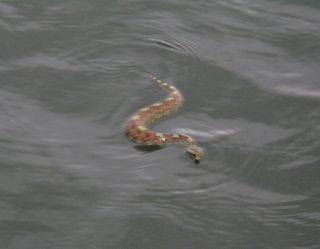 I’d like to say that the picture is blurry for artistic purposes, but its tough shooting from a rocking boat at sunset!
I’d like to say that the picture is blurry for artistic purposes, but its tough shooting from a rocking boat at sunset!
 Manatee salad
Manatee salad Sunset on the lagoon
Sunset on the lagoon

 This may not look exciting to many of you, but given how few complete West African manatee skeletons there are for education and scientific study, this is a gold mine!
This may not look exciting to many of you, but given how few complete West African manatee skeletons there are for education and scientific study, this is a gold mine!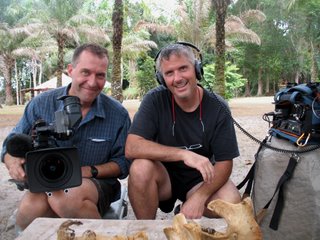

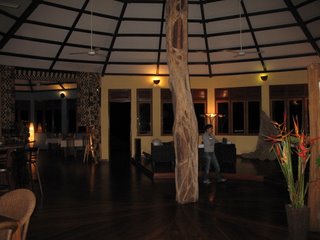 The main building. Guest dining room is on the left, salon area on the right. The bar and staff dining area (convienently near the bar!) is below.
The main building. Guest dining room is on the left, salon area on the right. The bar and staff dining area (convienently near the bar!) is below. 
 The gazebo out on the lagoon.
The gazebo out on the lagoon. The scientist's quarters, very comfortable!
The scientist's quarters, very comfortable! Snake swimming on the lagoon. It was about 3 feet long. I am not sure of the species, it wasn't in the reptile book here. Anyone have any ideas? Click on the photo to enlarge it and see the markings on it's head.
Snake swimming on the lagoon. It was about 3 feet long. I am not sure of the species, it wasn't in the reptile book here. Anyone have any ideas? Click on the photo to enlarge it and see the markings on it's head.